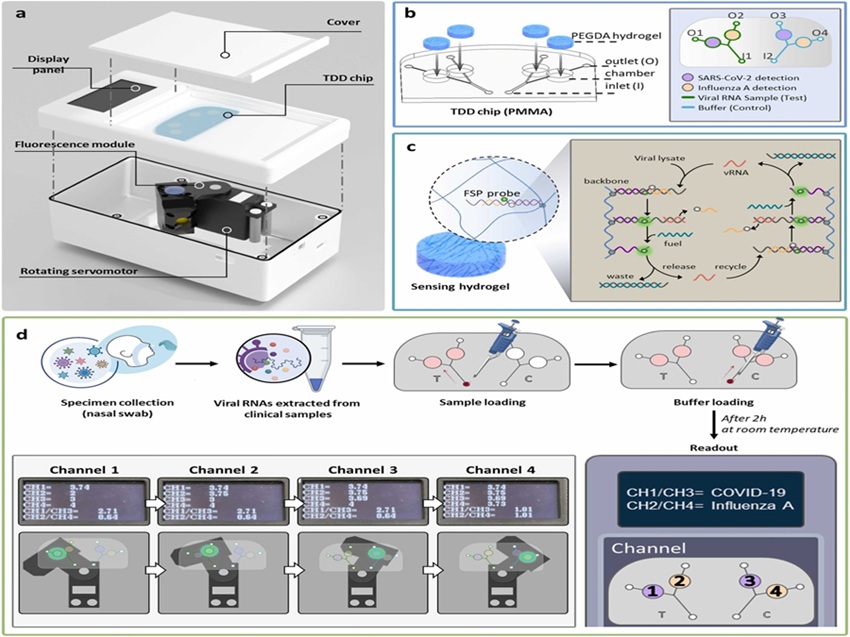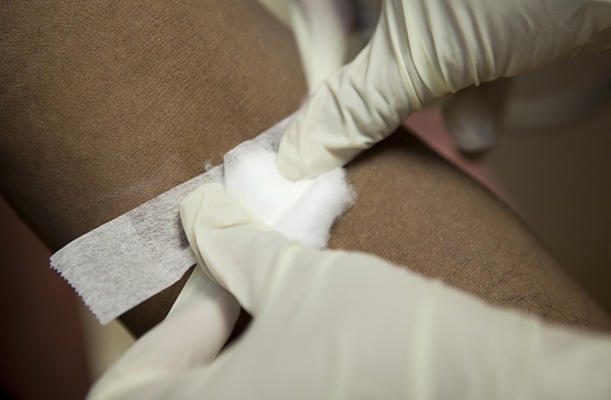“TwinDemic" Diagnostic System Rapidly and Simultaneously Detects SARS-CoV-2 and Influenza A Virus
|
By LabMedica International staff writers Posted on 16 Jan 2025 |

The COVID-19 pandemic in 2019 sparked efforts to raise public awareness about pandemics and led to accelerated vaccine development. While these actions effectively reduced viral transmission, they also resulted in unintended consequences, such as a decrease in the spread of other viruses and disruptions in vaccination schedules. However, rapidly mutating pathogens like viruses remain a significant threat, with predictions suggesting future co-infections could lead to "twindemics" or "tripledemics." Reverse Transcriptase-quantitative PCRs (RT-qPCRs) are reliable diagnostic assays, but their reliance on expensive equipment and reagents limits their use in resource-limited settings. This creates a need for a rapid, sensitive, and accurate molecular diagnostic tool capable of detecting multiple viruses at the point-of-care. To address this need, a novel tool has been developed for the simultaneous and rapid detection of SARS-CoV-2 and influenza A virus.
Researchers from Incheon National University (INU, Incheon, South Korea) have developed the TwinDemic Detection (TDD) system, a point-of-care diagnostic tool that uses a novel, non-enzymatic signal amplification method. The TDD system includes a transparent poly (methyl methacrylate) microfluidic chip with hydrogel-based, enzyme-free gene detection sensors, along with a handheld fluorescence reader. These hydrogel chambers are embedded with customized probes designed to detect the target viral pathogens, SARS-CoV-2 and influenza A. The reaction between the target viral DNA and the specific probe amplifies the fluorescence signal. The TDD system is user-friendly, cost-effective, and has a detection limit of 0.46 picomolar (pM) for SARS-CoV-2 and 0.39 pM for influenza A virus. When tested with human nasopharyngeal samples, TDD was shown to simultaneously detect both SARS-CoV-2 and influenza A, demonstrating its potential for rapid on-site testing of a wide range of viruses.
To assess the diagnostic accuracy of the TDD system, 15 nasopharyngeal swabs each from healthy individuals, COVID-19 patients, and those with influenza A were tested. The results, published in Sensors and Actuators B: Chemical, showed that for COVID-19, the TDD system correctly identified positive samples in 93.3% of cases and negative samples in 96.7%. For influenza A, positive and negative samples were correctly identified in 100% and 96.7% of cases, respectively. This study highlights the TDD system as a promising novel diagnostic tool for accurate and rapid simultaneous detection of multiple viruses at the point of care, potentially enabling clinicians to make timely and informed treatment decisions.
"The application of our TDD system can be further expanded by introducing additional channels and sensing hydrogels on the microfluidic chip, as well as integrating highly sensitive nucleic acid amplification systems for simultaneous detection and differentiation of a wider range of viruses," said INU’s Professor Eunjung Kim who led the TDD’s development.
Latest Molecular Diagnostics News
- First-Of-Its-Kind Automated System Speeds Myeloma Diagnosis
- Blood Protein Profiles Predict Mortality Risk for Earlier Medical Intervention
- First Of Its Kind Blood Test Detects Gastric Cancer in Asymptomatic Patients
- Portable Molecular Test Detects STIs at POC in 15 Minutes
- Benchtop Analyzer Runs Chemistries, Immunoassays and Hematology in Single Device
- POC Bordetella Test Delivers PCR-Accurate Results in 15 Minutes
- Pinprick Blood Test Could Detect Disease 10 Years Before Symptoms Appear
- Refined C-Reactive Protein Cutoffs Help Assess Sepsis Risk in Preterm Babies
- Blood Test Accurately Detects Brain Amyloid Pathology in Symptomatic Patients
- New Molecular Test Improves Diagnostic Accuracy of Lyme Disease
- New Genetic Test Enables Faster Diagnosis of Rare Diseases
- Urine Test Detects Inherited Neuropathy Missed by Genetic Screening
- Genomic Test Predicts Risk of SCC Metastasis
- Microfluidic Device Predicts Pancreatic Cancer Recurrence After Surgery
- New Molecular Test Simultaneously Detects Three Major Fungal Infections
- Blood Test Guides More Effective Ovarian Cancer Treatment
Channels
Clinical Chemistry
view channel
Chemical Imaging Probe Could Track and Treat Prostate Cancer
Prostate cancer remains a leading cause of illness and death among men, with many patients eventually developing resistance to standard hormone-blocking therapies. These drugs often lose effectiveness... Read more
Mismatch Between Two Common Kidney Function Tests Indicates Serious Health Problems
Creatinine has long been the standard for measuring kidney filtration, while cystatin C — a protein produced by all human cells — has been recommended as a complementary marker because it is influenced... Read moreHematology
view channel
Platelet Activity Blood Test in Middle Age Could Identify Early Alzheimer’s Risk
Early detection of Alzheimer’s disease remains one of the biggest unmet needs in neurology, particularly because the biological changes underlying the disorder begin decades before memory symptoms appear.... Read more
Microvesicles Measurement Could Detect Vascular Injury in Sickle Cell Disease Patients
Assessing disease severity in sickle cell disease (SCD) remains challenging, especially when trying to predict hemolysis, vascular injury, and risk of complications such as vaso-occlusive crises.... Read more
ADLM’s New Coagulation Testing Guidance to Improve Care for Patients on Blood Thinners
Direct oral anticoagulants (DOACs) are one of the most common types of blood thinners. Patients take them to prevent a host of complications that could arise from blood clotting, including stroke, deep... Read moreImmunology
view channel
Gene Signature Test Predicts Response to Key Breast Cancer Treatment
DK4/6 inhibitors paired with hormone therapy have become a cornerstone treatment for advanced HR+/HER2– breast cancer, slowing tumor growth by blocking key proteins that drive cell division.... Read more
Chip Captures Cancer Cells from Blood to Help Select Right Breast Cancer Treatment
Ductal carcinoma in situ (DCIS) accounts for about a quarter of all breast cancer cases and generally carries a good prognosis. This non-invasive form of the disease may or may not become life-threatening.... Read moreMicrobiology
view channel
Rapid Assay Identifies Bloodstream Infection Pathogens Directly from Patient Samples
Bloodstream infections in sepsis progress quickly and demand rapid, precise diagnosis. Current blood-culture methods often take one to five days to identify the pathogen, leaving clinicians to treat blindly... Read more
Blood-Based Molecular Signatures to Enable Rapid EPTB Diagnosis
Extrapulmonary tuberculosis (EPTB) remains difficult to diagnose and treat because it spreads beyond the lungs and lacks easily accessible biomarkers. Despite TB infecting 10 million people yearly, the... Read more
15-Minute Blood Test Diagnoses Life-Threatening Infections in Children
Distinguishing minor childhood illnesses from potentially life-threatening infections such as sepsis or meningitis remains a major challenge in emergency care. Traditional tests can take hours, leaving... Read more
High-Throughput Enteric Panels Detect Multiple GI Bacterial Infections from Single Stool Swab Sample
Gastrointestinal (GI) infections are among the most common causes of illness worldwide, leading to over 1.7 million deaths annually and placing a heavy burden on healthcare systems. Conventional diagnostic... Read morePathology
view channel
AI Tool Outperforms Doctors in Spotting Blood Cell Abnormalities
Diagnosing blood disorders depends on recognizing subtle abnormalities in cell size, shape, and structure, yet this process is slow, subjective, and requires years of expert training. Even specialists... Read more
AI Tool Rapidly Analyzes Complex Cancer Images for Personalized Treatment
Complex digital biopsy images that typically take an expert pathologist up to 20 minutes to assess can now be analyzed in about one minute using a new artificial intelligence (AI) tool. The technology... Read moreTechnology
view channel
AI Saliva Sensor Enables Early Detection of Head and Neck Cancer
Early detection of head and neck cancer remains difficult because the disease produces few or no symptoms in its earliest stages, and lesions often lie deep within the head or neck, where biopsy or endoscopy... Read more
AI-Powered Biosensor Technology to Enable Breath Test for Lung Cancer Detection
Detecting lung cancer early remains one of the biggest challenges in oncology, largely because current tools are invasive, expensive, or unable to identify the disease in its earliest phases.... Read moreIndustry
view channel
Abbott Acquires Cancer-Screening Company Exact Sciences
Abbott (Abbott Park, IL, USA) has entered into a definitive agreement to acquire Exact Sciences (Madison, WI, USA), enabling it to enter and lead in fast-growing cancer diagnostics segments.... Read more






















